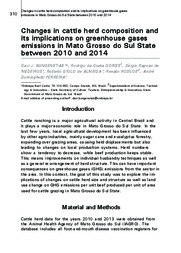Changes in cattle herd composition and its implications on greenhouse gases emissions in Mato Grosso do Sul State between 2010 and 2014.
Changes in cattle herd composition and its implications on greenhouse gases emissions in Mato Grosso do Sul State between 2010 and 2014.
Autoria: BUNGENSTAB, D. J.; GOMES, R. da C.; MEDEIROS, S. R. de; ALMEIDA, R. G. de; ROSCOE, R.; FERREIRA, A. D.
Resumo: Cattle ranching is a major agricultural activity in Central Brazil and it plays a major economic role in Mato Grosso do Sul State. In the last few years, local agricultural development has been influenced by other agro-industries, mainly sugar cane and eucalyptus forestry, expanding over grazing areas, causing herd displacements but alsoleading to changes on local production systems. Herd numbersshow a tendency to decrease, while beef production keeps stable.This means improvements on individual husbandry techniques as wellas a general re-arrangement of herd structure. This can have important consequences on greenhouse gases (GHG) emissions from the sector inthe area. In this context, the goal of this study was to explore the implications of changes on cattle herd size and structure as well as land use change on GHG emissions per unit beef produced per unit of area used for cattle grazing in Mato Grosso do Sul State.
Ano de publicação: 2016
Tipo de publicação: Artigo em anais e proceedings
Unidade: Embrapa Gado de Corte
Palavras-chave: Cattle
Observações
1 - Por padrão são exibidas publicações dos últimos 20 anos. Para encontrar publicações mais antigas, configure o filtro ano de publicação, colocando o ano a partir do qual você deseja encontrar publicações. O filtro está na coluna da esquerda na busca acima.
2 - Para ler algumas publicações da Embrapa (apenas as que estão em formato ePub), é necessário ter, no celular ou computador, um desses softwares gratuitos. Sistemas Android: Google Play Livros; IOS: iBooks; Windows e Linux: software Calibre.
Acesse outras publicações
Acesse a Base de Dados da Pesquisa Agropecuária (BDPA) para consultar o acervo completo das bibliotecas da Embrapa.

